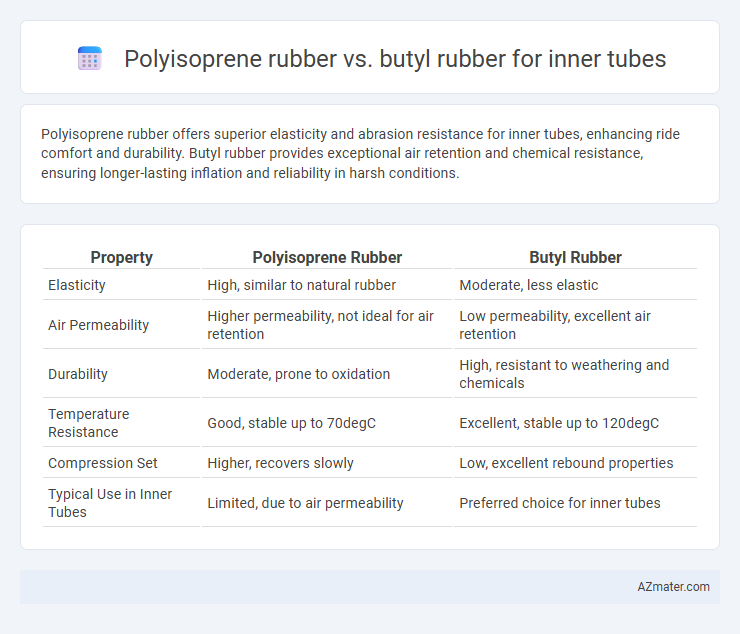Polyisoprene rubber offers superior elasticity and abrasion resistance for inner tubes, enhancing ride comfort and durability. Butyl rubber provides exceptional air retention and chemical resistance, ensuring longer-lasting inflation and reliability in harsh conditions.
Table of Comparison
| Property | Polyisoprene Rubber | Butyl Rubber |
|---|---|---|
| Elasticity | High, similar to natural rubber | Moderate, less elastic |
| Air Permeability | Higher permeability, not ideal for air retention | Low permeability, excellent air retention |
| Durability | Moderate, prone to oxidation | High, resistant to weathering and chemicals |
| Temperature Resistance | Good, stable up to 70degC | Excellent, stable up to 120degC |
| Compression Set | Higher, recovers slowly | Low, excellent rebound properties |
| Typical Use in Inner Tubes | Limited, due to air permeability | Preferred choice for inner tubes |
Introduction to Inner Tube Materials
Polyisoprene rubber offers excellent elasticity and resilience, closely mimicking natural rubber properties, making it suitable for inner tubes requiring high flexibility and durability. Butyl rubber excels in air impermeability and chemical resistance, providing superior air retention and resistance to ozone and weathering, critical for maintaining tire pressure over time. Choosing between polyisoprene and butyl rubber depends on the specific performance demands of inner tubes, balancing elasticity with airtightness for optimal functionality.
Overview of Polyisoprene Rubber
Polyisoprene rubber, a synthetic version of natural rubber, offers excellent elasticity and resilience, making it ideal for inner tube applications requiring high flexibility and durability. It provides superior tensile strength and abrasion resistance compared to butyl rubber, resulting in enhanced performance under dynamic conditions. Polyisoprene's natural damping properties improve ride comfort, while its lower air permeability compared to natural rubber maintains tire inflation longer than many other elastomers.
Key Properties of Butyl Rubber
Butyl rubber offers superior impermeability to gases, making it the preferred choice for inner tubes due to its excellent air retention and resistance to leakage. Its outstanding chemical resistance and good flexibility at low temperatures enhance durability and performance under varying conditions. Compared to polyisoprene rubber, butyl also exhibits enhanced resistance to heat, ozone, and weathering, contributing to longer inner tube lifespan.
Air Retention: Polyisoprene vs Butyl
Butyl rubber exhibits superior air retention properties compared to polyisoprene rubber, making it the preferred choice for inner tubes requiring prolonged inflation stability. Polyisoprene, although more flexible and resilient, has higher gas permeability, leading to faster air loss over time. The enhanced impermeability of butyl rubber ensures inner tubes maintain pressure longer, reducing the frequency of inflation and improving overall tire performance.
Durability and Puncture Resistance
Polyisoprene rubber offers excellent flexibility and resilience, providing good durability in inner tubes but is more susceptible to punctures compared to butyl rubber. Butyl rubber is highly valued for its superior puncture resistance and air retention capabilities, making it more durable in harsh conditions for inner tubes. The chemical structure of butyl rubber, with its dense polymer chains, enhances resistance to wear and tear, outperforming polyisoprene in long-term puncture protection.
Performance in Extreme Temperatures
Polyisoprene rubber offers excellent flexibility and maintains elasticity at low temperatures, making it suitable for cold environments, but it tends to degrade faster under prolonged high heat exposure. Butyl rubber excels in resistance to heat and chemical degradation, providing superior performance in extreme high temperatures while maintaining good air retention and durability. For inner tubes used in varying extreme climates, butyl rubber is generally preferred due to its enhanced heat resistance and longevity.
Ride Comfort and Flexibility
Polyisoprene rubber offers superior ride comfort and flexibility for inner tubes due to its high elasticity and excellent resilience, which absorb shocks effectively. Butyl rubber, while more impermeable and durable, tends to be stiffer, providing less cushioning and a firmer ride experience. The enhanced stretchability of polyisoprene results in smoother handling and improved vibration dampening compared to the relatively rigid butyl inner tubes.
Cost and Availability Comparison
Polyisoprene rubber for inner tubes offers a lower cost due to its more abundant raw materials and simpler processing techniques compared to butyl rubber. Butyl rubber, while more expensive, is less widely available because of its complex synthesis and specialized production requirements. Cost-effectiveness and supply chain stability favor polyisoprene rubber in mass-market inner tube applications, whereas butyl rubber is preferred when durability justifies higher material costs.
Environmental Impact and Sustainability
Polyisoprene rubber, derived from natural latex, offers superior biodegradability compared to synthetic Butyl rubber, making it a more environmentally sustainable choice for inner tubes. Butyl rubber, produced from petrochemical sources, has a longer degradation period and results in higher carbon emissions during manufacturing. The natural origin and faster decomposition of Polyisoprene contribute to lower ecological footprint and support circular economy initiatives in automotive applications.
Conclusion: Which Rubber Is Best for Inner Tubes?
Polyisoprene rubber offers excellent elasticity and resilience, providing superior ride comfort and puncture resistance for inner tubes, making it ideal for high-performance applications. Butyl rubber excels in air retention and durability, ensuring longer inner tube life and less frequent inflation for everyday use. For optimal inner tube performance, polyisoprene is best suited for performance-focused riders, while butyl rubber is preferred for general-purpose and durability needs.

Infographic: Polyisoprene rubber vs Butyl rubber for Inner tube
 azmater.com
azmater.com